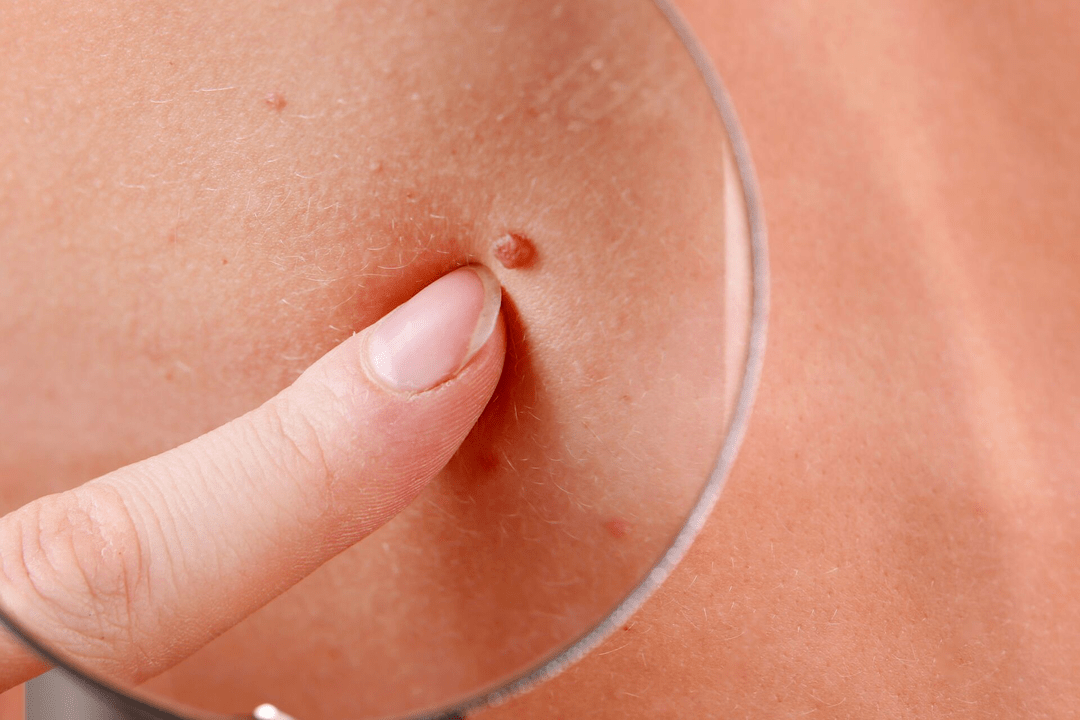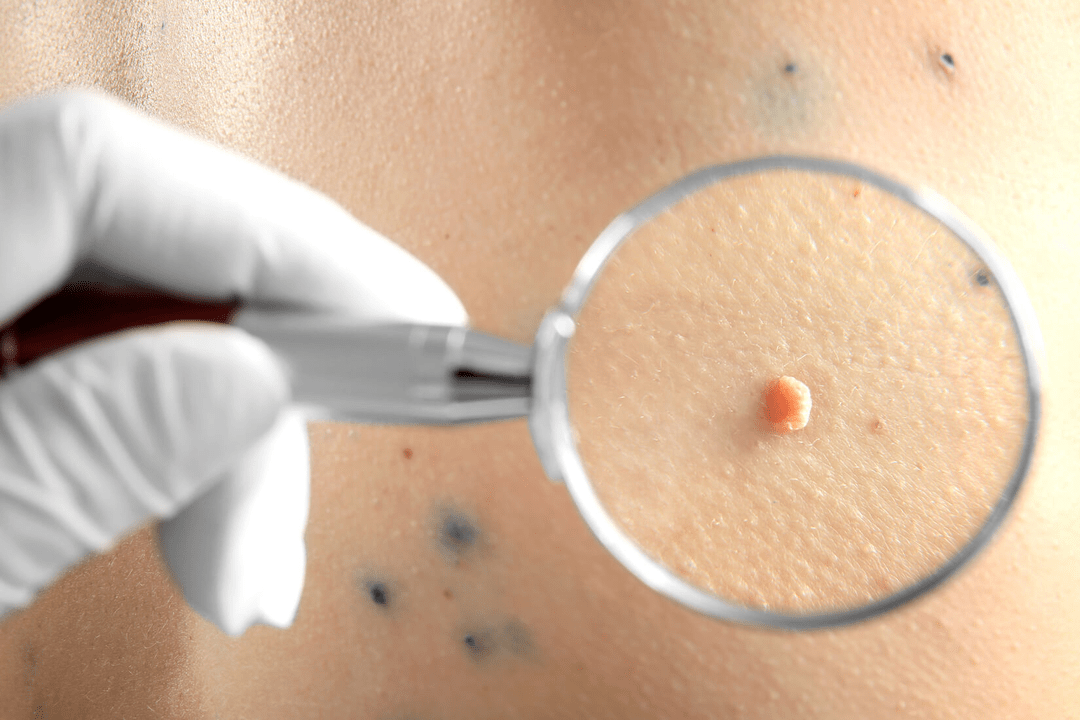
Papillomas on the body are formations on the skin that can be caused by various factors. Papillomas can be caused by viral infections, hormonal imbalances, skin lesions, or a weakened immune system.
One of the main causes of the development of papillomas is the human papilloma virus (HPV). Papillomas often appear after infection with HPV, which is transmitted through contact with infected skin or mucous membranes. Some types of HPV can cause skin tags on various parts of the body, including the face, neck, arms, and legs.
- External factors such as injuries, bruises or the penetration of foreign bodies into the skin can also lead to the development of papillomas.
- Hormonal changes, especially during pregnancy or menopause, can lead to the appearance of papillomas.
- A weakened immune system may not be able to fight viruses and bacteria, which can contribute to the development of papillomas.
There are several ways to treat papillomas. One of them is the use of drugs containing substances that destroy viral cells and contribute to the death of papillomas. Methods of freezing, burning or removing papillomas using laser technology can also be used. In some cases, surgery to remove papillomas may be required.
It is important to remember that removing papillomas on your own can be dangerous and lead to complications. Therefore, it is recommended to see a specialist.
In general, prevention is an important aspect of preventing papillomas. This includes maintaining good hygiene, using personal protective equipment when in contact with infected people, and maintaining a strong immune system through regular intake of vitamins and minerals, a healthy lifestyle, and moderate physical activity.
Papillomas on the body: occurrence and treatment methods
There are various methods of treating papillomas on the body. One of the most common methods is removal of papillomas with a laser. Laser removal of papillomas allows you to painlessly and effectively remove tumors. Another method is cryodestruction, which involves freezing the papilloma with liquid nitrogen, leading to its death and subsequent rejection. The chemical method is also often used to treat papillomas. In this case, special compounds are applied to the neoplasm, which cause necrosis of the papilloma tissue. Surgical removal of papillomas is carried out in cases where other methods of treatment do not bring results or in cases where the oncological nature of papillomas cannot be excluded.
| Treatment method | particularities |
|---|---|
| Laser removal | An initial visit to the doctor is not necessary. The procedure is painless and effective. |
| Cryodestruction | The procedure is carried out by a doctor using liquid nitrogen. Swelling and redness may occur at the site of papilloma removal. |
| Chemical removal | The use of special compounds against papilloma. Tissue death and tumor rejection. |
| Surgical removal | It is carried out in the operating room if the papilloma is of an oncological nature or there are no results of other treatment methods. |
Reasons for the formation of papillomas
In addition to the human papilloma virus, other factors that contribute to the appearance of papillomas in the body can also affect the functioning of the immune system. The immune system is weakened for various reasons, including stress, lack of sleep, poor diet, uncontrolled medication and other unfavorable factors. When the body's immune defenses decrease, the human papilloma virus is activated and leads to the development of papillomatous formations.
| The main reasons for the formation of papillomas | Examples |
|---|---|
| Infection with the human papillomavirus | HPV strains 6 and 11 cause the formation of papillomas in the genital area, HPV 1 and 2 – papillomas on the skin of the hands and feet |
| Weakened immune system | Papillomas can form if there are disorders in the general condition of the body or diseases that affect immunity |
Symptoms and types of papillomas
The symptoms of papillomas can vary depending on the type of papilloma and its location on the body. However, the main symptoms often observed in patients with papillomas include the following:
- Visible growths on the skin or mucous membrane: Papillomas often appear as small warts or flat bumps that are visible on the body or in the genital area.
- Changes in the color or shape of skin lesions: Papillomas can change color or shape over time, which can indicate possible problems.
- Pain or itching: Some skin tags may become painful or itchy, especially if they are in areas of friction or in areas where the skin is thinner and more sensitive.
There are several types of papillomas that can appear on the body:
- Viral papillomas: These papillomas are caused by human papilloma viruses (HPV) and can be contagious. They can appear on the skin, oral mucous membranes, genitals or anus. Viral papillomas include flat warts, cervical papillomas and genital warts.
- Keratotic papillomas: These are a type of papillomas characterized by a rough surface and a yellowish hue. They usually appear on the face, neck or arms. Keratotic papillomas are not contagious and have an unfavorable appearance.
- Phyllodes papillomas: These papillomas develop in the breast and can be malignant. They usually occur in women and can lead to breast enlargement or the development of new nipples.
The impact of papillomas on health
Papillomas on the body can have a negative impact on human health. They can cause discomfort and pain, especially if they are in areas where there is friction or clothing rubs. Papillomas can also cause aesthetic problems, as their presence can visually affect the overall appearance of the skin.
Another important factor associated with papillomas is their potentially dangerous nature. Some types of papillomas can be oncogenic and lead to the development of cancer. For example, the uncontrolled growth of papillomas on the cervix can be a harbinger of cervical cancer. In this regard, it is recommended to consult a doctor and undergo annual gynecological and dermatological examinations in order to detect papillomas and treat them in a timely manner.
The table below shows the main factors affecting the health of papillomas:
| Influencing factors | Description |
|---|---|
| Discomfort and pain | Papillomas in areas of friction or friction with clothing can cause discomfort and pain. |
| Aesthetic problems | The presence of papillomas on the skin can negatively affect a person's appearance. |
| The danger of oncology | Some types of papillomas may be oncogenic and pose a risk of cancer. |
Papillomas on the body can cause discomfort, impaired vision and are potentially dangerous. Therefore, timely consultation with a doctor and preventive examinations are recommended.
Factors contributing to the development of papillomas
Papillomas on the body can arise for various reasons. They are caused by the influence of the human papillomavirus (HPV) on the human body. The virus is transmitted through contact with the skin or mucous membranes of an infected person. However, not all people infected with HPV develop papillomas. This is due to the presence of special factors that contribute to their formation and development.
Factors contributing to the development of papillomas:
- Weak immune system: A weakened immune system allows the HPV virus to attack the skin or mucous membranes, which can lead to the development of papillomas.
- Skin damage: Microtrauma or wounds on the skin can be a portal of entry for the HPV virus, which contributes to the development of papillomas.
- Age: Age-related changes in the body can affect the ability to fight the HPV virus, increasing the risk of developing papillomas.
Avoiding exposure to the HPV virus and maintaining a healthy immune system through proper diet, physical activity, and quitting smoking can reduce the risk of developing skin tags.
Methods for removing papillomas

- Surgical removal: The doctor removes the papilloma using a scalpel or scissors. This method is usually used to remove large papillomas or those that may be suspicious of cancer. Surgical removal may leave scars or scar tissue after the procedure.
- Electrocoagulation: In this method, the papilloma is burned using electric current. Using an electrocoagulator, the doctor applies a high-frequency electrical current to the papilloma, causing it to burn. This procedure can be painful but usually does not require pain relief.
- Cryodestruction: In this method, the papilloma is removed by applying cold. The doctor uses liquid nitrogen to change the temperature of the papilloma, causing it to solidify and then die. Cryotherapy may cause pain or burning, but anesthesia is usually not necessary.
- Laser Removal: In this method, the papilloma is removed using a laser beam. Laser papilloma removal can be more precise and effective than other methods and is often used to remove papillomas on the face or other visible areas. Laser removal typically leaves no scars or scar tissue.
It is important to understand that each method of removing papillomas has its own advantages and disadvantages. It is best to discuss with your doctor which method is suitable for your specific case. Some methods may be more suitable for removing certain types of papillomas or depending on their location.
Prevention of the appearance of papillomas on the body
Papillomas on the body can be caused by various factors, including the human papilloma virus (HPV), skin damage, weakened immunity and others. Although some skin tags may disappear on their own, you can take some precautions to reduce your risk of infection.
- Maintain good skin hygiene: Regular body washing and skin care will help remove excess dirt and bacteria that can cause skin damage and infection. Particular attention should be paid to hand hygiene as they can be a source of transmission of the HPV virus.
- Avoid skin trauma: Papillomas can appear on damaged skin. Therefore, it is recommended to avoid trauma such as insect bites, scratches and wounds to reduce the risk of developing papillomas.
- Strengthen your immune system: A strong immune system helps protect your body from various infections, including the HPV virus. To strengthen the immune system, proper nutrition, moderate physical activity, avoiding bad habits and getting enough sleep are recommended.
Important to know: Despite precautionary measures, the appearance of papillomas on the body cannot always be avoided. If you develop new papillomas or suspect that they are malignant, it is recommended to see a doctor immediately for a diagnosis and appropriate treatment.
Treatment of papillomas at home
Treatment of papillomas at home is possible in some cases. However, before using home methods, you must take into account that papillomas can be of different nature and require an individual approach. Therefore, before starting treatment, it is recommended to consult a doctor to obtain a professional assessment of the condition and recommendations for further action.
- Taking medication. Some papillomas can be removed using special ointments, creams, acidic solutions or other active ingredients. The use is only recommended after prior examination and medical recommendation.
- The use of folk remedies. You can try to remove some papillomas on the body with folk remedies such as garlic, onion, apple cider vinegar, lemon juice or vegetable oils. However, before taking such medications, you must be aware of possible side effects and allergic reactions.
- Preparation and use of freshly squeezed juices. Some papillomas can be removed with freshly squeezed juices such as aloe vera juice, pomegranate juice, lemon juice or nettle juice. The risk of possible burns or skin irritation must be taken into account.
It is important to remember that although home treatment of papillomas can be effective in some cases, uncontrolled use of traditional remedies can lead to adverse consequences. Therefore, it is recommended to consult a doctor to receive individual recommendations and choose the optimal treatment method.
When should you see a doctor?

Even if papillomas cause discomfort or pain, you should consult a doctor. Papillomas that bleed, itch, or become inflamed may indicate an infection or another problem that requires medical attention. The doctor can find out the cause of the unpleasant symptoms and prescribe appropriate treatment.

















